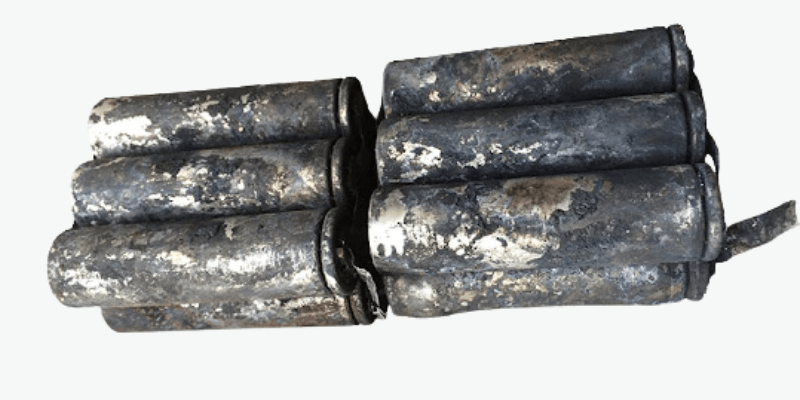Klucz na wynos:
- Zapoznaj się z przewodnikiem dotyczącym awarii akumulatorów litowo-jonowych, omawiającym problemy z ładowarkami, zwarciami, przebiciami, obrzękami i przegrzaniami, wraz ze wskazówkami dotyczącymi zapobiegania i bezpiecznej obsługi.
jest twój niestandardowa bateria litowa słabo radzi sobie? Dzisiaj przyjrzyjmy się przyczynom awarii akumulatorów i dowiedzmy się, jak im zapobiegać.
Problemy z ładowarką
Używanie niewłaściwej ładowarki może powodować problemy, takie jak przeładowanie i puchnięcie akumulatorów litowych.
Ładowarki zaprojektowano tak, aby zapobiegały przeładowaniu, ale niewłaściwa ładowarka może powodować ten problem.
Akumulatorów litowych nigdy nie należy ładować w temperaturze poniżej 32°F. Może to prowadzić do trwałego pokrycia litem anody, przez co akumulator będzie bardziej podatny na uszkodzenia.
Nadmierne rozładowanie jest takim samym problemem jak przeładowanie akumulatorów litowo-jonowych.
Napięcie nigdy nie powinno spaść poniżej 2 woltów, ponieważ anoda i katoda ulegną uszkodzeniu.
Po naładowaniu powyżej 2 woltów kolektor prądu anodowego rozpuści się, a jony miedzi mogą wytrącić się, powodując zwarcia. Katoda uwalnia również tlen, co prowadzi do trwałej utraty pojemności.
Zwarcie ogniwa
Pożary baterii litowych często wynikają z kontaktu cząstek metalicznych wewnątrz baterii, co powoduje zwarcia.
Podczas gdy drobne zwarcia prowadzą jedynie do samorozładowania, większe zwarcia mogą wywołać niekontrolowaną reakcję termiczną, w wyniku której ciepło powoduje korozję izolacji i powoduje spalanie. Ten problem jest zwykle spowodowany problemami produkcyjnymi, które umożliwiają gromadzenie się pyłu metalicznego.
Aby zapobiec tym awariom, można poprawić kontrolę jakości i wykorzystać czyste pomieszczenia w celu ograniczenia wytwarzania pyłu.
Przebicie i wyciek
Użytkownicy końcowi mogą podczas użytkowania doświadczyć przebić i wycieków z akumulatorów litowych wysyłka, transportu i obsługi.
Przebicie nastąpi, gdy elektrolit wycieknie w wyniku kontaktu z ostrymi przedmiotami, kroplami lub innymi naprężeniami mechanicznymi. Wielkość wycieku różni się w zależności od rozmiaru akumulatora i liczby przebitych ogniw.
Przebicia i wycieki mogą być niebezpieczne. Użytkownicy powinni zachować środki ostrożności, aby unikać kontaktu z wyciekającymi elektrolitami, ponieważ mogą one spowodować zwarcie w pobliskich urządzeniach elektronicznych.
Puchnięcie akumulatora
Obudowa baterii może być wybrzuszona z powodu pęcznienia baterii litowej. Może się to zdarzyć z kilku powodów, takich jak wnikanie wilgoci, przeładowanie lub starzenie się.
W miarę starzenia się akumulatora może to powodować wzrost temperatury.
Aby zapobiec pęcznieniu akumulatora, należy unikać narażania pakietu na działanie wilgoci i ograniczać ciągłe ładowanie.
Problemy z ogrzewaniem
Przegrzanie jest częstą awarią baterii litowej, która zazwyczaj jest spowodowana przeładowaniem lub wysoką temperaturą.
Ucieczka termiczna to kolejny problem, który może mieć wpływ na akumulatory litowo-jonowe, w których elektrolit i katoda ulegają rozkładowi z powodu nadmiernej temperatury wewnętrznej i ciśnienia. Spowoduje to gromadzenie się gazu i ryzyko zapłonu lub eksplozji.
Systemy zarządzania akumulatorami (BMS) zaprojektowano tak, aby zapobiegały utracie ciepła poprzez monitorowanie i regulację czynników, takich jak przeładowanie, przepięcie i temperatura. BMS zapewnia pracę akumulatora w bezpiecznych granicach i może przechowywać informacje diagnostyczne pomocne w rozwiązywaniu problemów.
Co zrobić, gdy akumulator ulegnie awarii
BMS zapobiega większości problemów z akumulatorami. Inne problemy, takie jak zwarcia lub starzenie się, po prostu powodują, że akumulator przestaje działać.
Powinien być świadomy zagrożeń, takich jak wycieki i niestabilność termiczna. W przypadku wycieku umieść akumulator litowo-jonowy w zamykanej torbie i wyczyść elektrolit sokiem z cytryny lub octem.
W przypadku awarii pakiet może syczeć, wydzielać gazy, zapalać się lub eksplodować. Traktuj go jak zwykły pożar, używając gaśnicy pianowej, węglanu sodu lub wody.
Jeżeli bateria litowa spęczniała, wyjmij ją z urządzenia i skontaktuj się z serwisem producent do zwrotu lub właściwej utylizacji.
Wniosek
Podsumowując, do głównych przyczyn awarii akumulatorów litowo-jonowych należą problemy z ładowarką, zwarcia ogniw, przebicia i wycieki, puchnięcie zestawu akumulatorów i przegrzanie. Właściwe użycie ładowarki, kontrola jakości i systemy zarządzania akumulatorem mają kluczowe znaczenie, aby zapobiec tym awariom.
W przypadku awarii akumulatora litowo-jonowego ważne jest, aby obchodzić się z nim bezpiecznie, eliminując wszelkie wycieki i prawidłowo utylizując akumulator.
Powiązane artykuły:
- Nowe trendy w niestandardowych projektach akumulatorów litowych
- Jak wybrać najlepszego producenta akumulatorów litowych
- Jak wybrać najlepszą płytę ochronną dla akumulatorów litowych
- 10 najlepszych producentów akumulatorów litowych w Chinach
- Produkcja niestandardowych akumulatorów litowych: kompleksowy przewodnik po procesie technicznym

